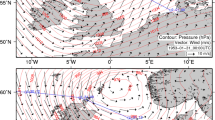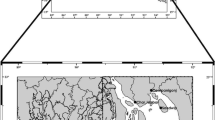Abstract
An unstructured mesh finite element model of the sea region off the west coast of Britain is used to examine the storm surge event of November 1977. This period is chosen because accurate meteorological data to drive the model and coastal observations for validation purposes are available. In addition, previous published results from a coarse-grid (resolution 7 km) finite difference model of the region and high-resolution (1 km) limited area (namely eastern Irish Sea) model are available for comparison purposes. To enable a “like with like” comparison to be made, the finite element model covers the same domain and has the same meteorological forcing as these earlier finite difference models. In addition, the mesh is based on an identical set of water depths. Calculations show that the finite element model can reproduce both the “external” and “internal” components of the surge in the region. This shows that the “far field” (external) component of the surge can accurately propagate through the irregular mesh, and the model responds accurately, without over- or under-damping, to local wind forcing. Calculations show significant temporal and spatial variability in the surge in close agreement with that found in earlier finite difference calculations. In addition, root mean square errors between computed and observed surge are comparable to those found in previous finite different calculations. The ability to vary the mesh in nearshore regions reveals appreciable small-scale variability that was not found in the previous finite difference solutions. However, the requirement to perform a “like with like” comparison using the same water depths means that the full potential of the unstructured grid model to improve resolution in the nearshore region is inhibited. This is clearly evident in the Mersey estuary region where a higher resolution unstructured mesh model, forced with uniform winds, had shown high topographic variability due to small-scale variations in topography that are not resolved here. Despite the lack of high resolution in the nearshore region, the model showed results that were consistent with the previous storm surge models of the region. Calculations suggest that to improve on these earlier results, a finer nearshore mesh is required based upon accurate nearshore topography.

























Similar content being viewed by others
References
Davies AM, Flather RA (1977) Computation of the storm surge of 1–6 April 1973 using numerical models of the northwest European continental shelf and North Sea. Dtsch Hydrogr Z 30:139–162
Davies AM, Jones JE (1992a) A three-dimensional wind driven circulation model of the Celtic and Irish Seas. Cont Shelf Res 12:159–188
Davies AM, Jones JE (1992b) A three dimensional model of the M2, S2, N2, K1 and O1 tides in the Celtic and Irish Sea. Prog Oceanogr 29:197–234
Davies AM, Lawrence J (1995) Modelling the effect of wave–current interaction on the three-dimensional wind driven circulation of the eastern Irish Sea. J Phys Oceanogr 25:29–45
Davies AM, Jones JE (1996) Sensitivity of tidal bed stress distributions, near bed currents, overtides and tidal residuals to frictional effects in the eastern Irish Sea. J Phys Oceanogr 26:2553–2575
Davies AM, Hall P (2002) Numerical problems associated with coupling models in shelf edge regions. Appl Math Model 26:807–831
Davies AM, Kwong SCM, Flather RA (1998) A three-dimensional model of wind-driven circulation on the shelf: application to the storm of January 1993. Cont Shelf Res 18:289–340
Davies AM, Kwong SCM, Flather RA (2000) On determining the role of wind wave turbulence and grid resolution upon computed storm driven currents. Cont Shelf Res 20:1825–1888
Davies AM, Hall P, Howarth MJ, Knight P, Player R (2001) A detailed comparison of measured and modeled wind driven currents in the North Channel of the Irish Sea. J Geophys Res 106:19683–19713
Fernandes EHL, Dyer KR, Moller OO, Niencheski LFH (2002) The Patos lagoon hydrodynamics during an El Nino event (1998). Cont Shelf Res 22:1699–1713
Fernandes EHL, Marino-Tapia I, Dyer KR, Moller OO (2004) The attenuation of tidal and subtidal oscillations in the Patos Lagoon estuary. Ocean Dynamics 54:348–359
Greenberg DA, Dupont F, Lyard FH, Lynch DR, Werner FE (2007) Resolution issues in numerical models of oceanic and coastal circulation. Cont Shelf Res 27:1317–1343
Hagen S, Westerink J, Kolar R, Horstmann O (2001) Two dimensional unstructured mesh generation for tidal models. Int J Numer Methods Fluids 35:669–686
Hagen SC, Horstmann O, Bennett RJ (2002) An unstructured mesh generation algorithm for shallow water modeling. Int J Comput Fluid Dyn 16(2):83–91
Ip JTC, Lynch DR, Friedrichs CT (1998) Simulation of estuarine flooding and dewatering with application to Great Bay, New Hampshire. Estuar Coast Shelf Sci 47:119–141
Jones JE (2002) Coastal and shelf-sea modelling in the European context. Oceanogr Mar Biol: an Annual Review 40:37–141
Jones JE, Davies AM (1996) A high resolution three dimensional model of the M2, M4, M6, S2, N2, K1, and O1 tides in the eastern Irish Sea. Estuar Coast Shelf Sci 42:311–346
Jones JE, Davies AM (1998) Storm surge computations for the Irish Sea using a three-dimensional numerical model including wave–current interaction. Cont Shelf Res 18:201–251
Jones JE, Davies AM (2001) Influence of wave–current interaction and high frequency forcing upon storm induced currents and elevations. Estuar Coast Shelf Sci 53:397–414
Jones JE, Davies AM (2003a) Processes influencing storm-induced currents in the Irish Sea. J Phys Oceanogr 33:88–104
Jones JE, Davies AM (2003b) On combining current observations and models to investigate the wind induced circulation of the eastern Irish Sea. Cont Shelf Res 23:415–434
Jones JE, Davies AM (2005) An intercomparison between finite difference and finite element (TELEMAC) approaches to modelling west coast of Britain tides. Ocean Dynamics 55:178–198
Jones JE, Davies AM (2006) Application of a finite element model (TELEMAC) to computing the wind induced response of the Irish Sea. Cont Shelf Res 26:1519–1541
Jones JE, Davies AM (2007a) A high resolution finite element model of the M2, M4, M6, S2, N2, K1 and O1 tides off the west coast of Britain. Ocean Model 19:70–100
Jones JE, Davies AM (2007b) On the sensitivity of computed higher tidal harmonics to mesh size in a finite element model. Cont Shelf Res 27:1908–1927
Jones JE, Davies AM (2007c) On the sensitivity of tidal residuals off the west coast of Britain to mesh resolution. Cont Shelf Res 27:64–81
Jones JE, Davies AM (2008) On the modification of tides in shallow water regions by wind effects. J Geophys Res 113:C05014
Legrand S, Deleersnijder E, Hanert E, Legat V, Wolanski E (2006) High-resolution, unstructured meshes for hydrodynamic models of the Great Barrier Reef, Australia. Estuar Coast Shelf Sci 68:36–46
Legrand S, Deleersnijder E, Delhez E, Legat V (2007) Unstructured, anisotropic mesh generation for the Northwestern European continental shelf, the continental slope and the neighbouring ocean. Cont Shelf Res 27:1344–1356
Levasseur A, Shi L, Wells NC, Purdie DA, Kelly-Gerreyn BA (2007) A three-dimensional hydrodynamic model of estuarine circulation with an application to Southampton Water, U.K. Estuar Coast Shelf Sci 73:753–767
Nicolle A, Karputchev M (2007) Evidence for spatially variable friction from tidal amplification and asymmetry in a shallow semi-diurnal embayment: the Pertuis Breton Bay of Biscay, France. Cont Shelf Res 27:2346–2356
Walters RA (2005) Coastal ocean models: two useful finite element methods. Cont Shelf Res 25:775–793
Werner FE (1995) A field test case for tidally forced flows: a review of the tidal flow forum. In: Lynch DR, Davies AM (eds) Quantitative skill assessment for coastal ocean models. American Geophysical Union, USA, pp 269–284
Acknowledgements
The origin of the TELEMAC system is EDF-LNHE and is therefore ©EDF-LNHE. The authors are indebted to R.A. Smith for help in preparing diagrams and L. Parry for typing the paper.
Author information
Authors and Affiliations
Corresponding author
Additional information
Responsible Editor: Eric Deleersnijder
Rights and permissions
About this article
Cite this article
Jones, J.E., Davies, A.M. Storm surge computations for the west coast of Britain using a finite element model (TELEMAC). Ocean Dynamics 58, 337–363 (2008). https://doi.org/10.1007/s10236-008-0140-y
Received:
Accepted:
Published:
Issue Date:
DOI: https://doi.org/10.1007/s10236-008-0140-y




